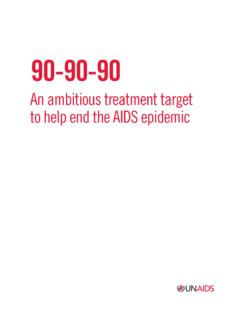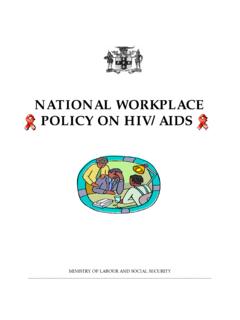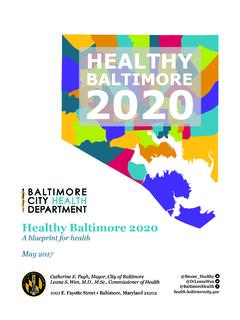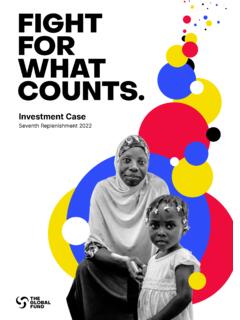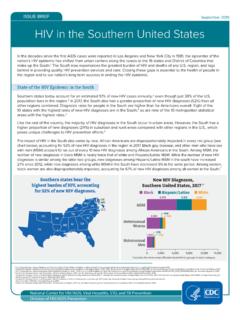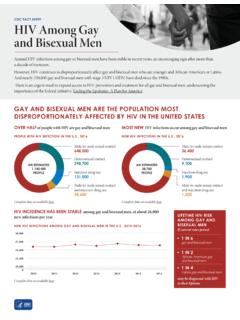Transcription of HIV National Strategic Plan for the United States: A ...
1 HIVN ational Strategic PlanA Roadmap to End the Epidemicfor the United States | 2021 2025iHIV National Strategic plan : 2021 2025 VISIONThe United States will be a place where new HIV infections are prevented, every person knows their status, and every person with HIV has high-quality care and treatment and lives free from stigma and vision includes all people, regardless of age, sex, gender identity, sexual orientation, race, ethnicity, religion, disability, geographic location, or socioeconomic National Strategic plan : 2021 2025iiAcknowledgments: The HIV National Strategic plan (HIV plan ) was developed through an inclusive and cooperative process that included input and feedback from stakeholders across public health, health care, research, and related fields.
2 Partners throughout the federal government, as well as input from hundreds of nonfederal stakeholders including state, tribal, territorial, and local governments, researchers, health plans and providers, community groups, and National and local organizations that work in HIV and related fields, have helped shape the goals, objectives, and strategies in this plan . The Office of the Assistant Secretary for Health (OASH) and its Office of Infectious Disease and HIV/AIDS Policy (OIDP) of the Department of Health and Human Services (HHS) sincerely thank all those who contributed to making this HIV plan a reality. Language used in the HIV plan : The HIV plan values the lived experiences and choices of all people, regardless of age, sex, gender identity, sexual orientation, race, ethnicity, religion, disability, geographic location, or socioeconomic circumstance.
3 To reflect this vision, a concerted effort was made to use inclusive and person-first language throughout the HIV plan . Evidence-based, contemporary terminology is also used to convey respect and empowerment and to reduce stigma faced by communities and populations disproportionately impacted by HIV. Despite these efforts, specific terminology or language may be unintentionally offensive or stigmatizing to some individuals or populations. This approach is intended to reflect the HIV plan s vision for a collective, inclusive, and respectful National response. Additional information regarding the HIV plan and associated activities may be accessed at citation: Department of Health and Human Services. 2021. HIV National Strategic plan for the United States: A Roadmap to End the Epidemic 2021 2025.
4 Washington, HIV plan is not a budget document and does not imply approval for any specific action under Executive Order 12866 or the Paperwork Reduction Act. The Strategy will inform the Federal budget and regulatory development processes within the context of the goals articulated in the President s Budget. All activities included in the Strategy are subject to budgetary constraints and other approvals, including the weighing of priorities and available resources by the Administration in formulating its annual budget and by Congress in legislating National Strategic plan : 2021 2025iiiTABLE OF CONTENTSE xecutive Summary ..1I. Introduction ..6A. HIV Epidemic: Progress to Date ..6B. HIV in the United States Today ..7C. HIV National Strategic plan : Roadmap to End the Epidemic 2021 2025.
5 16D. Priority Populations ..18E. Key Focus Areas ..19F. Development of the HIV National Strategic plan ..20II. Goals and Related Objectives, Strategies, and Indicators of Progress ..22 Goal 1: Prevent New HIV Infections ..22 Goal 2: Improve HIV-Related Health Outcomes of People with HIV ..31 Goal 3: Reduce HIV-Related Disparities and Health 4: Achieve Integrated, Coordinated Efforts That Address the HIV Epidemic among All Partners and Stakeholders ..45 III. Implementation and Accountability ..53A. Federal Partners ..53B. Nonfederal Partners ..53 Appendix A: Process/Methodology for Developing and Adopting the HIV plan ..54 Appendix B: Federal Steering Committee, Subcommittees, and Staff ..63 Appendix C: Acronyms ..68 Appendix D: References.
6 70 HIV National Strategic plan : 2021 2025ivTables, Figures, and Boxes Tables Table 1. Proportion of People with HIV by Race/Ethnicity Compared to Proportion of Population, 2018 ..9 Table 2. HIV Transmissions in 2016 ..13 Table 3. Definitions Included in the HIV plan ..21 Table Composition of Joint Viral Hepatitis/HIV Federal Steering Committee ..55 Table Dominant Themes from Public Comments ..57 Table Priority Populations and Summary National -Level Data, Calendar Year 2018 ..58 Figures Figure 1. Annual HIV infections in the United States, 2014 2018 ..8 Figure 2. HIV infections by race and transmission group, United States, 2014 vs. 2018 ..8 Figure 3. HIV incidence by race/ethnicity, 2018 ..9 Figure 4. 57 jurisdictions prioritized in the Ending the HIV Epidemic initiative.
7 10 Figure 5. HIV prevention and treatment toolkits ..11 Figure 6. Prevalence-based HIV care continuum, 2018 ..13 Figure 7. Status neutral approach to HIV ..28 Figure 8 . The HIV care continuum ..31 Figure 9. State criminal HIV exposure laws, as of 2020 ..42 Figure Respondent type for all public comments with available affiliation ..56 Figure New HIV diagnoses in the United States and dependent areas for the most-affected .. subpopulations, Figure Disparities along the HIV care continuum among Black gay, bisexual, and other men who .. have sex with men, 2018 ..61 Figure Disparities along the HIV care continuum among youth, aged 13 24, 2018 ..61 HIV National Strategic plan : 2021 2025vTables, Figures, and Boxes Boxes Box 1.
8 HIV National Strategic plan and Ending the HIV Epidemic: A plan for America ..17 Box 2. Missed Opportunities for HIV Diagnosis ..24 Box 3. Opportunities for Enhanced HIV Prevention Services in STD Specialty Clinics ..25 Box 4. HIV Testing Recommendations ..27 Box 5. Status Neutral Approach to HIV ..28 Box 6. Pharmacists Roles in HIV Prevention and Care ..30 Box 7. State HIV Criminalization Laws ..41 Box 8. Addressing HIV Prevention and Care Across the Lifespan ..44 HIV National Strategic plan : 2021 2025 Executive Summary | 1 EXECUTIVE SUMMARYB uilding on lessons learned and progress made in the past 40 years, the United States now has the opportunity to end the HIV epidemic. This opportunity has been made possible by tireless advocacy, determined research, and dedicated delivery of diagnostic, prevention, care, treatment, and supportive National HIV/AIDS Strategy, first released in 2010 and updated in 2015, changed the way Americans talk about HIV and the ways stakeholders prioritize and coordinate resources and deliver prevention and care services that support people with or at risk for HIV.
9 The nation s new HIV infections have declined from their peak in the mid-1980s, and people with HIV in care and treatment are living longer, healthier lives. However, not all groups have experienced decreases in HIV infections or improvements in HIV-related health outcomes. In 2018, the estimated number of new HIV infections was 36,400. A robust prevention toolbox that includes pre-exposure prophylaxis (PrEP), post-exposure prophylaxis (PEP), and syringe services programs (SSPs) has lowered a person s risk of acquiring HIV. Research in recent years has proven that people with HIV who take antiretroviral therapy achieve and maintain an undetectable viral load not only protect their health but also have effectively no risk of transmitting HIV through stability in the annual number of new infections, though, has further illuminated opportunities for focused efforts.
10 According to the most recent available data, just over one-third (39%) of the population have ever been tested for HIV1 and an estimated 161,800 (14%) people with HIV are unaware of their Only 56% of people with HIV were virally suppressed in Approximately 80% of new HIV infections are due to people who do not know they have HIV or are not receiving regular care,4 and only 18% of the approximately million people indicated for PrEP are receiving ,5 This HIV National Strategic plan (HIV plan ), the nation s third consecutive National HIV strategy, sets forth bold targets for ending the HIV epidemic in the United States by 2030, including a 75% reduction in new HIV infections by 2025 and a 90% reduction by 2030. For stakeholders across the nation, the HIV plan articulates goals, objectives, and strategies to prevent new infections, treat people with HIV to improve health outcomes, reduce HIV-related disparities, and better integrate and coordinate the efforts of all partners to achieve the bold targets for ending the HIV epidemic in the United States.

